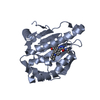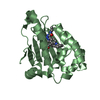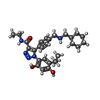[English] 日本語
 Yorodumi
Yorodumi- PDB-8agi: Structure of human Heat shock protein 90-alpha N-terminal domain ... -
+ Open data
Open data
- Basic information
Basic information
| Entry | Database: PDB / ID: 8agi | ||||||
|---|---|---|---|---|---|---|---|
| Title | Structure of human Heat shock protein 90-alpha N-terminal domain (Hsp90-NTD) in complex with JMC31 | ||||||
 Components Components | Heat shock protein HSP 90-alpha Heat shock response Heat shock response | ||||||
 Keywords Keywords |  CHAPERONE / CHAPERONE /  Hsp90 / NTD / 1 / 2 / 3-triazole-based compound / Hsp90 / NTD / 1 / 2 / 3-triazole-based compound /  complex complex | ||||||
| Function / homology |  Function and homology information Function and homology informationsperm mitochondrial sheath /  dATP binding / Scavenging by Class F Receptors / dATP binding / Scavenging by Class F Receptors /  sulfonylurea receptor binding / CTP binding / positive regulation of protein polymerization / vRNP Assembly / UTP binding / sperm plasma membrane / positive regulation of tau-protein kinase activity ...sperm mitochondrial sheath / sulfonylurea receptor binding / CTP binding / positive regulation of protein polymerization / vRNP Assembly / UTP binding / sperm plasma membrane / positive regulation of tau-protein kinase activity ...sperm mitochondrial sheath /  dATP binding / Scavenging by Class F Receptors / dATP binding / Scavenging by Class F Receptors /  sulfonylurea receptor binding / CTP binding / positive regulation of protein polymerization / vRNP Assembly / UTP binding / sperm plasma membrane / positive regulation of tau-protein kinase activity / protein insertion into mitochondrial outer membrane / sulfonylurea receptor binding / CTP binding / positive regulation of protein polymerization / vRNP Assembly / UTP binding / sperm plasma membrane / positive regulation of tau-protein kinase activity / protein insertion into mitochondrial outer membrane /  chaperone-mediated autophagy / chaperone-mediated autophagy /  telomerase holoenzyme complex assembly / Rho GDP-dissociation inhibitor binding / Uptake and function of diphtheria toxin / mitochondrial transport / Drug-mediated inhibition of ERBB2 signaling / Resistance of ERBB2 KD mutants to trastuzumab / Resistance of ERBB2 KD mutants to sapitinib / Resistance of ERBB2 KD mutants to tesevatinib / Resistance of ERBB2 KD mutants to neratinib / Resistance of ERBB2 KD mutants to osimertinib / Resistance of ERBB2 KD mutants to afatinib / Resistance of ERBB2 KD mutants to AEE788 / Resistance of ERBB2 KD mutants to lapatinib / telomerase holoenzyme complex assembly / Rho GDP-dissociation inhibitor binding / Uptake and function of diphtheria toxin / mitochondrial transport / Drug-mediated inhibition of ERBB2 signaling / Resistance of ERBB2 KD mutants to trastuzumab / Resistance of ERBB2 KD mutants to sapitinib / Resistance of ERBB2 KD mutants to tesevatinib / Resistance of ERBB2 KD mutants to neratinib / Resistance of ERBB2 KD mutants to osimertinib / Resistance of ERBB2 KD mutants to afatinib / Resistance of ERBB2 KD mutants to AEE788 / Resistance of ERBB2 KD mutants to lapatinib /  Drug resistance in ERBB2 TMD/JMD mutants / PIWI-interacting RNA (piRNA) biogenesis / TPR domain binding / Drug resistance in ERBB2 TMD/JMD mutants / PIWI-interacting RNA (piRNA) biogenesis / TPR domain binding /  non-chaperonin molecular chaperone ATPase / regulation of postsynaptic membrane neurotransmitter receptor levels / dendritic growth cone / Sema3A PAK dependent Axon repulsion / skeletal muscle contraction / regulation of protein ubiquitination / positive regulation of cell size / protein unfolding / HSF1-dependent transactivation / telomere maintenance via telomerase / response to unfolded protein / HSF1 activation / chaperone-mediated protein complex assembly / regulation of protein-containing complex assembly / Attenuation phase / RHOBTB2 GTPase cycle / positive regulation of lamellipodium assembly / eNOS activation / non-chaperonin molecular chaperone ATPase / regulation of postsynaptic membrane neurotransmitter receptor levels / dendritic growth cone / Sema3A PAK dependent Axon repulsion / skeletal muscle contraction / regulation of protein ubiquitination / positive regulation of cell size / protein unfolding / HSF1-dependent transactivation / telomere maintenance via telomerase / response to unfolded protein / HSF1 activation / chaperone-mediated protein complex assembly / regulation of protein-containing complex assembly / Attenuation phase / RHOBTB2 GTPase cycle / positive regulation of lamellipodium assembly / eNOS activation /  DNA polymerase binding / axonal growth cone / Tetrahydrobiopterin (BH4) synthesis, recycling, salvage and regulation / Loss of Nlp from mitotic centrosomes / Loss of proteins required for interphase microtubule organization from the centrosome / positive regulation of cardiac muscle contraction / Signaling by ERBB2 / cardiac muscle cell apoptotic process / Recruitment of mitotic centrosome proteins and complexes / positive regulation of telomerase activity / response to salt stress / positive regulation of defense response to virus by host / endocytic vesicle lumen / Recruitment of NuMA to mitotic centrosomes / HSP90 chaperone cycle for steroid hormone receptors (SHR) in the presence of ligand / Anchoring of the basal body to the plasma membrane / DNA polymerase binding / axonal growth cone / Tetrahydrobiopterin (BH4) synthesis, recycling, salvage and regulation / Loss of Nlp from mitotic centrosomes / Loss of proteins required for interphase microtubule organization from the centrosome / positive regulation of cardiac muscle contraction / Signaling by ERBB2 / cardiac muscle cell apoptotic process / Recruitment of mitotic centrosome proteins and complexes / positive regulation of telomerase activity / response to salt stress / positive regulation of defense response to virus by host / endocytic vesicle lumen / Recruitment of NuMA to mitotic centrosomes / HSP90 chaperone cycle for steroid hormone receptors (SHR) in the presence of ligand / Anchoring of the basal body to the plasma membrane /  protein tyrosine kinase binding / response to cold / activation of innate immune response / positive regulation of interferon-beta production / nitric-oxide synthase regulator activity / lysosomal lumen / Constitutive Signaling by Overexpressed ERBB2 / ESR-mediated signaling / AURKA Activation by TPX2 / VEGFR2 mediated vascular permeability / response to cocaine / brush border membrane / ATP-dependent protein folding chaperone / Signaling by ERBB2 TMD/JMD mutants / protein tyrosine kinase binding / response to cold / activation of innate immune response / positive regulation of interferon-beta production / nitric-oxide synthase regulator activity / lysosomal lumen / Constitutive Signaling by Overexpressed ERBB2 / ESR-mediated signaling / AURKA Activation by TPX2 / VEGFR2 mediated vascular permeability / response to cocaine / brush border membrane / ATP-dependent protein folding chaperone / Signaling by ERBB2 TMD/JMD mutants /  neuron migration / Constitutive Signaling by EGFRvIII / DDX58/IFIH1-mediated induction of interferon-alpha/beta / Signaling by ERBB2 ECD mutants / tau protein binding / Signaling by ERBB2 KD Mutants / Regulation of necroptotic cell death / Regulation of actin dynamics for phagocytic cup formation / Downregulation of ERBB2 signaling / cellular response to virus / VEGFA-VEGFR2 Pathway / Aggrephagy / Chaperone Mediated Autophagy / positive regulation of protein import into nucleus / response to estrogen / neuron migration / Constitutive Signaling by EGFRvIII / DDX58/IFIH1-mediated induction of interferon-alpha/beta / Signaling by ERBB2 ECD mutants / tau protein binding / Signaling by ERBB2 KD Mutants / Regulation of necroptotic cell death / Regulation of actin dynamics for phagocytic cup formation / Downregulation of ERBB2 signaling / cellular response to virus / VEGFA-VEGFR2 Pathway / Aggrephagy / Chaperone Mediated Autophagy / positive regulation of protein import into nucleus / response to estrogen /  histone deacetylase binding / positive regulation of protein catabolic process / The role of GTSE1 in G2/M progression after G2 checkpoint / histone deacetylase binding / positive regulation of protein catabolic process / The role of GTSE1 in G2/M progression after G2 checkpoint /  regulation of protein localization / positive regulation of nitric oxide biosynthetic process / disordered domain specific binding / regulation of protein localization / positive regulation of nitric oxide biosynthetic process / disordered domain specific binding /  Regulation of PLK1 Activity at G2/M Transition / unfolded protein binding / Regulation of PLK1 Activity at G2/M Transition / unfolded protein binding /  melanosome melanosomeSimilarity search - Function | ||||||
| Biological species |   Homo sapiens (human) Homo sapiens (human) | ||||||
| Method |  X-RAY DIFFRACTION / X-RAY DIFFRACTION /  SYNCHROTRON / SYNCHROTRON /  MOLECULAR REPLACEMENT / Resolution: 2.1 Å MOLECULAR REPLACEMENT / Resolution: 2.1 Å | ||||||
 Authors Authors | Tassone, G. / Pozzi, C. / Mazzorana, M. / Mangani, S. / Maramai, S. | ||||||
| Funding support | 1items
| ||||||
 Citation Citation |  Journal: Int J Mol Sci / Year: 2022 Journal: Int J Mol Sci / Year: 2022Title: Structural Characterization of Human Heat Shock Protein 90 N-Terminal Domain and Its Variants K112R and K112A in Complex with a Potent 1,2,3-Triazole-Based Inhibitor. Authors: Tassone, G. / Mazzorana, M. / Mangani, S. / Petricci, E. / Cini, E. / Giannini, G. / Pozzi, C. / Maramai, S. | ||||||
| History |
|
- Structure visualization
Structure visualization
| Structure viewer | Molecule:  Molmil Molmil Jmol/JSmol Jmol/JSmol |
|---|
- Downloads & links
Downloads & links
- Download
Download
| PDBx/mmCIF format |  8agi.cif.gz 8agi.cif.gz | 100.7 KB | Display |  PDBx/mmCIF format PDBx/mmCIF format |
|---|---|---|---|---|
| PDB format |  pdb8agi.ent.gz pdb8agi.ent.gz | 74.8 KB | Display |  PDB format PDB format |
| PDBx/mmJSON format |  8agi.json.gz 8agi.json.gz | Tree view |  PDBx/mmJSON format PDBx/mmJSON format | |
| Others |  Other downloads Other downloads |
-Validation report
| Arichive directory |  https://data.pdbj.org/pub/pdb/validation_reports/ag/8agi https://data.pdbj.org/pub/pdb/validation_reports/ag/8agi ftp://data.pdbj.org/pub/pdb/validation_reports/ag/8agi ftp://data.pdbj.org/pub/pdb/validation_reports/ag/8agi | HTTPS FTP |
|---|
-Related structure data
| Related structure data |  8agjC  8aglC  6gq6S S: Starting model for refinement C: citing same article ( |
|---|---|
| Similar structure data | Similarity search - Function & homology  F&H Search F&H Search |
- Links
Links
- Assembly
Assembly
| Deposited unit | 
| ||||||||
|---|---|---|---|---|---|---|---|---|---|
| 1 | 
| ||||||||
| 2 | 
| ||||||||
| Unit cell |
|
- Components
Components
| #1: Protein |  Heat shock response / Heat shock 86 kDa / HSP86 / Lipopolysaccharide-associated protein 2 / LPS-associated protein 2 / ...Heat shock 86 kDa / HSP86 / Lipopolysaccharide-associated protein 2 / LPS-associated protein 2 / Renal carcinoma antigen NY-REN-38 Heat shock response / Heat shock 86 kDa / HSP86 / Lipopolysaccharide-associated protein 2 / LPS-associated protein 2 / ...Heat shock 86 kDa / HSP86 / Lipopolysaccharide-associated protein 2 / LPS-associated protein 2 / Renal carcinoma antigen NY-REN-38Mass: 28773.145 Da / Num. of mol.: 2 Source method: isolated from a genetically manipulated source Source: (gene. exp.)   Homo sapiens (human) / Gene: HSP90AA1, HSP90A, HSPC1, HSPCA / Plasmid: pET28b / Production host: Homo sapiens (human) / Gene: HSP90AA1, HSP90A, HSPC1, HSPCA / Plasmid: pET28b / Production host:   Escherichia coli BL21(DE3) (bacteria) / References: UniProt: P07900 Escherichia coli BL21(DE3) (bacteria) / References: UniProt: P07900#2: Chemical | #3: Water | ChemComp-HOH / |  Water WaterHas ligand of interest | Y | |
|---|
-Experimental details
-Experiment
| Experiment | Method:  X-RAY DIFFRACTION / Number of used crystals: 1 X-RAY DIFFRACTION / Number of used crystals: 1 |
|---|
- Sample preparation
Sample preparation
| Crystal | Density Matthews: 2.45 Å3/Da / Density % sol: 49.77 % |
|---|---|
Crystal grow | Temperature: 281 K / Method: vapor diffusion, sitting drop / pH: 8.5 Details: 25% wt/vol PEG-4000, 200 mM magnesium chloride and 100 mM TRIS-HCl, pH 8.5 |
-Data collection
| Diffraction | Mean temperature: 100 K / Serial crystal experiment: N |
|---|---|
| Diffraction source | Source:  SYNCHROTRON / Site: SYNCHROTRON / Site:  Diamond Diamond  / Beamline: I04 / Wavelength: 0.9795 Å / Beamline: I04 / Wavelength: 0.9795 Å |
| Detector | Type: DECTRIS EIGER2 X 16M / Detector: PIXEL / Date: May 13, 2022 |
| Radiation | Monochromator: Si(111) / Protocol: SINGLE WAVELENGTH / Monochromatic (M) / Laue (L): M / Scattering type: x-ray |
| Radiation wavelength | Wavelength : 0.9795 Å / Relative weight: 1 : 0.9795 Å / Relative weight: 1 |
| Reflection | Resolution: 2.1→212.19 Å / Num. obs: 30642 / % possible obs: 88.6 % / Redundancy: 13 % / Biso Wilson estimate: 40.8 Å2 / CC1/2: 1 / Rmerge(I) obs: 0.055 / Rpim(I) all: 0.016 / Rrim(I) all: 0.057 / Net I/σ(I): 24.5 |
| Reflection shell | Resolution: 2.1→2.21 Å / Rmerge(I) obs: 0.754 / Mean I/σ(I) obs: 2.8 / Num. unique obs: 4410 / CC1/2: 0.871 / Rpim(I) all: 0.225 / Rrim(I) all: 0.788 |
- Processing
Processing
| Software |
| |||||||||||||||||||||||||||||||||||||||||||||
|---|---|---|---|---|---|---|---|---|---|---|---|---|---|---|---|---|---|---|---|---|---|---|---|---|---|---|---|---|---|---|---|---|---|---|---|---|---|---|---|---|---|---|---|---|---|---|
| Refinement | Method to determine structure : :  MOLECULAR REPLACEMENT MOLECULAR REPLACEMENTStarting model: 6GQ6 Resolution: 2.1→68.94 Å / Cor.coef. Fo:Fc: 0.958 / Cor.coef. Fo:Fc free: 0.934 / SU B: 5.941 / SU ML: 0.153 / Cross valid method: THROUGHOUT / σ(F): 0 / ESU R: 0.221 / ESU R Free: 0.211 / Stereochemistry target values: MAXIMUM LIKELIHOOD / Details: U VALUES : REFINED INDIVIDUALLY
| |||||||||||||||||||||||||||||||||||||||||||||
| Solvent computation | Ion probe radii: 0.8 Å / Shrinkage radii: 0.8 Å / VDW probe radii: 1.2 Å / Solvent model: MASK | |||||||||||||||||||||||||||||||||||||||||||||
| Displacement parameters | Biso max: 111.57 Å2 / Biso mean: 45.436 Å2 / Biso min: 21.36 Å2
| |||||||||||||||||||||||||||||||||||||||||||||
| Refinement step | Cycle: final / Resolution: 2.1→68.94 Å
| |||||||||||||||||||||||||||||||||||||||||||||
| Refine LS restraints |
| |||||||||||||||||||||||||||||||||||||||||||||
| LS refinement shell | Resolution: 2.1→2.155 Å / Rfactor Rfree error: 0 / Total num. of bins used: 20
|
 Movie
Movie Controller
Controller


 PDBj
PDBj






















